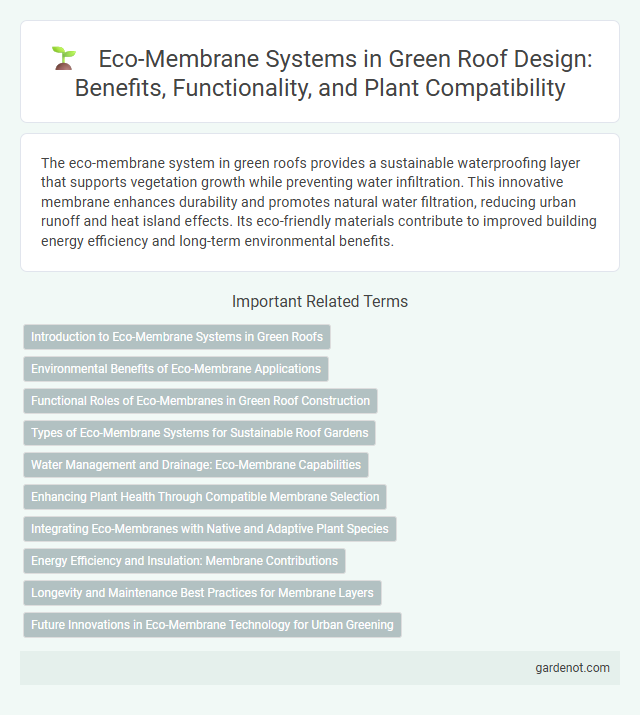The eco-membrane system in green roofs provides a sustainable waterproofing layer that supports vegetation growth while preventing water infiltration. This innovative membrane enhances durability and promotes natural water filtration, reducing urban runoff and heat island effects. Its eco-friendly materials contribute to improved building energy efficiency and long-term environmental benefits.
Introduction to Eco-Membrane Systems in Green Roofs
Eco-membrane systems in green roofs provide a durable, waterproof barrier that protects building structures while supporting vegetation growth. These membranes are designed with eco-friendly materials that enhance sustainability by reducing environmental impact and improving energy efficiency. Their integration facilitates effective water retention and drainage, promoting plant health and extending roof lifespan.
Environmental Benefits of Eco-Membrane Applications
Eco-membrane systems in green roofs significantly enhance urban sustainability by reducing heat island effects and improving air quality through natural filtration processes. These membranes facilitate efficient water management, minimizing stormwater runoff and promoting groundwater recharge, which mitigates erosion and flooding risks. Their biodegradable and non-toxic properties contribute to lower environmental impact during installation and end-of-life disposal, supporting eco-friendly building practices.
Functional Roles of Eco-Membranes in Green Roof Construction
Eco-membrane systems in green roof construction serve as crucial barriers that prevent water infiltration while allowing vapor permeability, ensuring root systems receive adequate moisture without causing structural damage. These membranes enhance the roof's durability by protecting underlying materials from UV radiation, temperature fluctuations, and mechanical stress. Their role in promoting sustainable water management through efficient drainage and retention contributes significantly to urban heat island mitigation and biodiversity support.
Types of Eco-Membrane Systems for Sustainable Roof Gardens
Eco-membrane systems for sustainable roof gardens include thermoplastic polyolefin (TPO), ethylene propylene diene monomer (EPDM), and polyvinyl chloride (PVC) membranes, each offering durability, flexibility, and waterproofing essential for green roof viability. TPO membranes provide high reflectivity and energy efficiency, while EPDM is favored for its elasticity and resistance to UV radiation, making it ideal for varying climate conditions. PVC membranes combine chemical resistance with ease of installation, supporting vegetation growth by preventing moisture loss and root penetration.
Water Management and Drainage: Eco-Membrane Capabilities
Eco-membrane systems in green roofs provide superior water management by efficiently controlling water retention and drainage, reducing runoff, and preventing soil erosion. Their advanced permeability allows excess water to drain while retaining sufficient moisture for plant health, promoting sustainable water use. These membranes also enhance durability and protect roof structures from water damage, contributing to long-term environmental and structural benefits.
Enhancing Plant Health Through Compatible Membrane Selection
Selecting an eco-membrane system with high permeability and non-toxic materials significantly enhances plant health on green roofs by optimizing water retention and root aeration. Membranes compatible with the specific plant species prevent root damage and promote robust growth cycles. Integrating biodegradable and UV-resistant membranes supports long-term vegetation vitality and sustainable green roof ecosystems.
Integrating Eco-Membranes with Native and Adaptive Plant Species
Integrating eco-membrane systems with native and adaptive plant species enhances green roof sustainability by improving moisture retention and promoting natural biodiversity. Eco-membranes provide an effective waterproof barrier while allowing root respiration, supporting resilient plant growth under variable weather conditions. Utilizing native and drought-tolerant species with eco-membranes reduces irrigation needs and strengthens urban ecosystem services.
Energy Efficiency and Insulation: Membrane Contributions
The eco-membrane system significantly enhances energy efficiency by providing superior thermal insulation that reduces heat transfer through roofing structures. This membrane layer minimizes cooling and heating demands, leading to lower energy consumption in buildings. Its advanced materials also contribute to maintaining stable indoor temperatures and improving overall insulation performance.
Longevity and Maintenance Best Practices for Membrane Layers
An eco-membrane system designed for green roofs significantly enhances longevity by using durable, UV-resistant materials that withstand environmental stressors for decades. Regular maintenance practices include periodic inspections to detect and repair punctures or blisters, ensuring water tightness and preventing root intrusion. Implementing proper drainage and avoiding sharp debris further prolongs membrane life, minimizing costly replacements and maintaining optimal green roof performance.
Future Innovations in Eco-Membrane Technology for Urban Greening
Future innovations in eco-membrane technology for urban greening include the development of bio-based, self-healing membranes that enhance durability and reduce environmental impact. Advanced nano-engineered materials improve water retention and permeability, supporting healthier plant growth on green roofs. Integration of smart sensors within membranes enables real-time monitoring of moisture and nutrient levels, optimizing maintenance and resource efficiency.
Eco-membrane system Infographic

 gardenot.com
gardenot.com